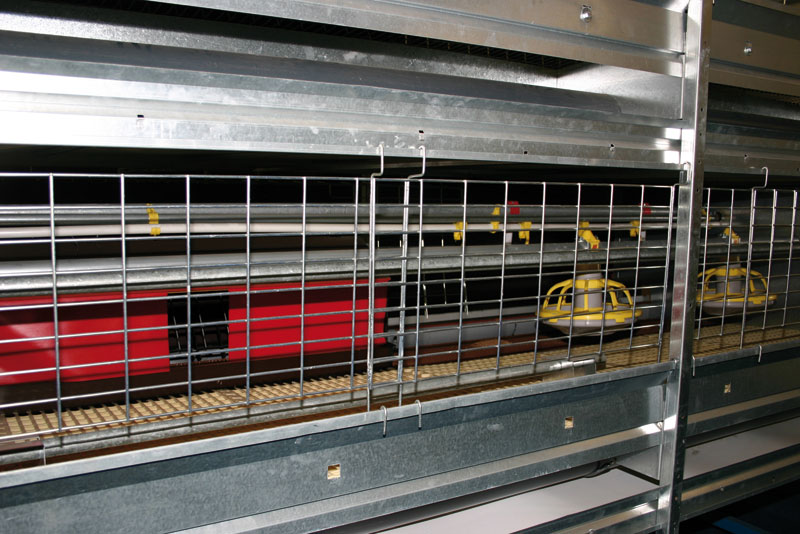
Research conducted in the United States suggests that the density at which chickens are stocked in enriched cage systems makes little difference to either production or animal well being.
The researchers, who were funded by the United States Poultry & Egg Association, looked into a range of stocking rates both higher and lower than the standard laid down under European Union regulations. But, according to US Poultry, they “found minimal differences in measures of produc-tion and well-being.” The study was conducted on laying birds between 17 and 69 weeks of age.
Enriched cages became the minimum production standard in the European Union on January 1 2012, when a regulation outlawing the use of battery cages came into force. Pressure is being mounted by welfare campaigners in the United States and other countries to follow the EU’s lead, but in the European Union the rules are already in force requiring egg producers who use cages to provide hens with a nest, perching space, litter to allow pecking and scratching and unrestricted ac-cess to a feed trough. Each hen must have at least 750 square centimetres of space.
During the new United States research project scientists studied birds housed at a range of stocking densities from 464 square centimetres to 929 square centimetres. They say they found that the stocking rate made little difference to the birds. The researchers, who were based at Michigan State University, have suggested that further work should now be conducted to look into other implica-tions of increasing or decreasing stocking density.
The US study was conducted by Dr Darrin M Karcher and Dr Maja M Makagon at the Department of Animal Sciences at Michigan State University. They said in a report on their work that consumers were expressing a greater interest in knowing that laying hens had “good well being.” Their per-ception was that the issue could be easily resolved with the use of alternative housing systems for laying hens and one housing system that was becoming more popular was the enriched colony cage system. They said that, as the commercial laying hen industry started to phase out the conventional cage, moving towards alternative housing systems, research studies needed data that could “provide guidance on management practices relative to the housing system.”
Their overarching objective in conducting the study, they said, was to investigate laying hen space allocation in enriched colony systems. “The long term goal was to provide a better understanding of how production and well being are entwined to aid producers in making sound decisions and pro-vide information to address issues raised by the consumer. The specific objectives for this grant were to 1) evaluate performance of a single strain of laying hens at different stocking densities in enriched colony cages and 2) assess impacts of different stocking densities on laying hen well being using measures of health, stress, and behaviour.”
The birds involved in the Michigan study were kept at six different stocking densities - 464 square centimetres, 580 square centimetres, 651 square centimetres, 748 square centimetres, 799 square centimetres and 929 square centimetres. The chickens were studied from 17 to 69 weeks of age and the research team analysed egg production, body weight, egg weight and feed disappearance, as well as a number of measures indicating the well being of the birds.
“Egg production declined over time with all treatments ending around 79 per cent, with the excep-tion of the 929 cm2 treatment, which ended around 82 percent,” they said in their report. “Egg weight, feed consumption and body weights were similar across all treatments.
“The other aspect of the trial was to evaluate the health, stress and behaviour of the birds using the European Union Welfare Quality (WQ) Assessment Protocol for Poultry (Welfare Quality Consor-tium, 2009). The avoidance distance test, which assesses the hen's response to humans, was not practical as the hens interacted with farm staff daily during egg collection and were habituated to human presence. The fear response of the hen was therefore only assessed using the novel object test. The hen's responses to the novel object, a colourful rod, were not different by density.”
They said, “According to the WQ protocol, hen health can be assessed through observation of hens with laboured breathing/sneezing and visual examination of faeces to identify enteric infections.
Based on these procedures, hen health was deemed not to be of issue. The lack of health concerns was confirmed by an avian pathologist, who conducted necropsies of mortality,” they said. “The welfare quality measures of comb abnormality, comb wound, keel deformation or fracture, skin le-sions, toe damage, foot condition and plumage damage were assessed bi-monthly in 10 per cent of each enriched colony population. Keel deformation or fracture increased over time and was similar amongst all treatments over time (20 to 30 per cent). The plumage damage was assessed on seven different areas of the hen. All areas became worse with time (increased feather loss or feather breakage) and the areas of the head, abdomen, and back were impacted by density with the propor-tion of hens having worse plumage quality in 464 cm2.”
The research team said that further research should be conducted and this should focus on finding the density between 651 square centimetres and 748 square centimetres at which improvements to feathering occurs.
